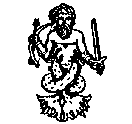
 |
Goods have been marked with personal marks for ages. We find it necessary to use personal marks to identify our goods, as well. Theatrically, we can not use a name on goods, for in our period, very few people were literate. The marks on the left are some you will see a lot of, as they belong to the Chief and officers and heads of Households of Clan MacColin. We have our own registry to help returning goods to members. |
Personal marks have been a way to identify and personalize goods for a very long time. They are appropriate for us in both the sixteenth and twentieth centuries. At events we have a very communal life leading to goods wandering all over our site. So we must have a way of getting them back to their owner. By having a Personal Mark Registry, we can ensure that everyone has a unique, identifiable mark, and a way to connect it to a name and person.
Because it requires group effort to make this work, we have a tax for the return of lost goods to help pay for our activities and discourage carelessness. The default claim fee for MARKED goods is $0.25, but for unmarked goods, the default rate is $1.00 per item, and the Chief may appraise a higher tax for some high value items, especially after it lands in the lost and found repeatedly. . It can save you money. Lack of a mark on a lost item quadruples the cost of getting it back. That basket of spinning goods might cost $2.00 to reclaim if your goods are marked, or $8.00 if unmarked! This reflects the aggravation involved, for unmarked goods are likely to remain in our garages much longer (more than 4 times) if their owners are not concerned enough to mark them. Your registered personal mark will save you money and aggravation. Eventually, unclaimed lost and found items end in clan auction.
It is easy to register your mark; just find a time at some meeting or event to review the Mark with Odo, and email for approval and registering. He will approve marks that are clear, unique, and appropriate, and once approved, it is permanently yours. The current Clan Apps have a place for recording it as well, providing another reference to help identify goods and get them home.
When you design your mark, bear in mind that you must remember it and put it on everything. Straight lines are easier to carve than curves, and simple line drawing with few pieces will get the job done much faster than an ornate multiple line width mark. Also note that it must be unique and recognizable dirty, worn, upside down, and sideways. Alphabetic charaters are not appropriate for us, and named designs are not personal. Look at goods to see who has what mark, and how it has held up, and how hard it is to tell who it belongs to, then use the lessons on your own. First, take a look at the Mark Registry for some hints as to how to design a mark, and note that you will need to create one that will be clearly yours even after wear and tear add some lines. A copy of it is in the kitchen at Faire, and household heads also get copies to help with this step, as well as figure out whose goods they are storing.
A good way to check to see if the mark you have in mind will work is to carve it several times in some scrap wood and give it a wear test. If dragging it across a nail or two in the table will make it hard to identify, try some more. If it takes long to make each mark, you probably will not mark half your goods, so try a design you can use on everything. Wood burning and clear carving (a groover or chip carving) tends to hold up well. Marks embroidered on fabric items help keep you well dressed. If the mark is clear, visible, and distinctive, it will help keep the goods coming home.
Save yourself money and grief. RECORD a mark, and USE IT! Learn
the marks and you can help people keep track of their goods (including
those coveted by others).